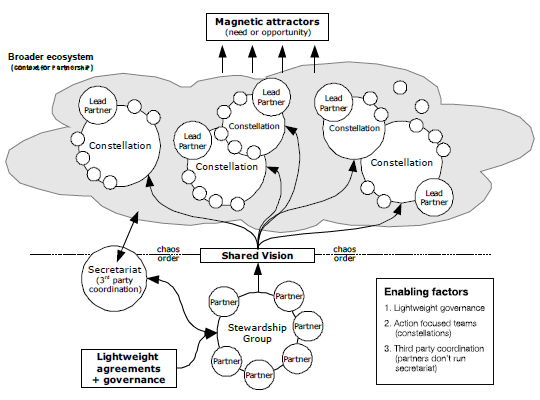The Constellation Collaboration Model offers an inspiring, and sensible, framework for organizations to come together, create partnership, and realize mutual objectives. It is the vision of Tonya Surman and Mark Surman, and builds on their work with the Centre for Social Innovation, “a social enterprise with a mission to catalyze social innovation”, based in Toronto, Ontario. The model is put into practice (quite successfully!) through lightweight governance, action focused teams, and third party coordination. Here’s one of the images Tonya and Mark use to convey the model:
From my view, the model reconciles partnership in our era of increasing complexity, conflict, networks, and general uncertainty. Needs and opportunities drive the flow of resources and action. Action is consistent higher level principles e.g., systems thinking. It’s far removed from the umbrella model of governance!
When I look at the diagram, it seems intuitively correct to me, especially when dealing with future uncertainty (and building on my post last week about intuition!). Features of the constellation collaboration model include:
1. Lightweight governance where:
- Partnerships are created to respond to specific needs or opportunities
- Partnership is governed by lightweight agreements (no legal entities created)
- A stewardship group provides overall strategy and terms of reference
- The prevailing rule-of-thumb is to have “as little process as possible”
- Most authority and decision making resides at the working (team) level
2. Action-focused teams (constellations) that:
- Are small and self-organizing
- “Flow” towards the need or opportunity
- “Build on energetic leadership”, leveraging self-interest
- “Are loosely coupled”; forming and dissolving; creating a rough and chaotic whole
3. Third-party coordination that:
- “Manages day-to-day coordination of the partnership”
- “Resides outside of the core partners” (freeing partner resources for action)
- Ensures all partners have opportunity to lead (a team)
- Facilitates coordinated (cross-partner) fundraising
- Troubleshoots problems; e.g., conflict resolution
Some of the challenges faced with practicing of the model include:
- Partner capacities (e.g., is there the staff or experience to run a collaborative, cross-organizational team?)
- Power imbalances between the partners (e.g., ensuring power isn’t pooled with one partner)
- Managing a virtual organization (remember: no legal corporate entity)
- Managing changes and growth (e.g., adding a new partner)
This appears to me to be a great model. From my vantage point, the Centre for Social Innovation is a unique, supportive place (I’ll have to check it out in-person next time I’m in TO!) for any organization with a social mission. I encourage you to check them out too. My own ideas around how to apply the model quickly flow to the role that online collaborative technologies could play; and build on my own experiences with Information and Communications Technologies and Online Dispute Resolution. Stay tuned!
What jumps to your mind about the constellation collaboration model?
If you enjoyed this post, please consider leaving a comment or subscribing to the feed to have future articles delivered to your feed reader.


Great stuff
Yep but need to digg into it.
Seems to be interesting
Solofo
Thanks for sharing this. I was really excited to read this because it gave a name to something similar to what I’ve been doing for about 16 years. In 1993 I recognized that no one had a master database of non profits offering tutoring/mentoring in the non-school hours, thus no effective advertising, marketing was in place that could help all of the existing programs get resources to grow, while also identifying areas where new programs were needed.
Since I had no money or social power to bring together a formal coalition, I built a solution out of my own emerging tutor/mentor program. I began to build a database of programs, based on an annual survey which I launched in 1994. Based on what programs were telling me were challenges, and my own understanding from operating my own program, I began to create events and actions that would draw volunteers and donors to all of the programs in my database.
Over the years my role as an intermediary has come to look something like that of the catalyst in this model of Constellations. I’ve been looking for a structure that would give us the “unity” of many groups working together, but would not reduce the flexibility of my group, or any other group, to act independently to try to impact common goals.
I hope to learn more about this idea, and to share it with others through my own networks. You can see how I apply these ideas on my own blog and web sites.
Dan,
Nice of you to connect here. And, glad you found a name for what you’ve been doing, for a long time! Tonya Surman (source behind the Constellation Collaboration idea) would be most happy. You might want to touch base with her. I’ll check out your website(s). I sense it is important work that you are doing. Ben.